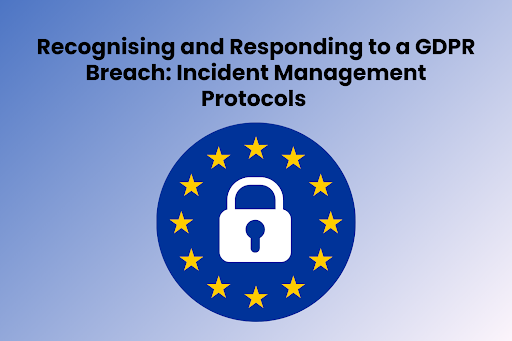In the digital era, people’s privacy and protection are the top priority. The General Data Protection Regulation (GDPR) is a strong framework that guarantees the responsible management of information and protects personal data. Even with strict protocols, breaches can happen. For organisations dedicated to compliance, knowing what constitutes a GDPR breach and having incident management procedures in place are essential.
This blog explores what is a GDPR Breach, the subtleties of identifying and handling a GDPR breach, stressing the significance of incident management procedures. This investigation seeks to illuminate practical incident response tactics for anyone seeking a GDPR Training Course, be they a business owner, a data protection officer, or another role in the industry.
Table Of Contents
- What is a GDPR Breach?
- Incident Management Protocols for GDPR Breaches
- The Role of GDPR Training Courses
- Conclusion
What is a GDPR Breach?
Any unauthorised access, disclosure, change, or destruction of personal data that jeopardises its confidentiality, integrity, or security is referred to as a GDPR breach. Personal data might be compromised in many ways, such as insider fraud, unintentional loss, or hacking. Organisations are required under the GDPR to notify the appropriate supervisory body of specific types of breaches within a predetermined amount of time. Let’s see the key components of a GDPR breach below.
Loss of Confidentiality
A breach of confidentiality occurs whenever unapproved parties obtain access to personal information and disclose it. This might be the consequence of an employee’s unintentional access, a cyberattack, or a data leak.
Integrity Compromise
Unauthorised changes or modification of personal data are breaches that compromise its integrity. This can involve unintentional alterations that affect the data’s accuracy or deliberate alterations made by malevolent parties.
Unauthorized Access
A GDPR breach is when someone obtains access to personal information without the required authorization. This might be a person taking advantage of security holes in the system, an insider with unauthorised access, or an outside hacker.
Loss of Availability
Loss of availability is the result of breaches that make personal data unavailable when needed. This can be the consequence of a ransomware assault, a malfunctioning system, or other events that block data access.
Incident Management Protocols for GDPR Breaches:
Preparation and Planning
Create a thorough incident response strategy that complies with GDPR. Roles and duties, communication tactics, and the precise actions to be followed in the case of a breach should all be outlined in this plan.
Data Mapping and Classification
To determine the categories of personal data handled and where they are located, carry out a comprehensive data mapping exercise. Sort data according to sensitivity to help you focus response efforts on the event of a breach.
Incident Identification
Put procedures and monitoring systems in place to quickly identify possible breaches. Early incident detection is facilitated by automated alarms, anomaly detection, and routine audits.
Internal Communication
Create effective channels of communication inside the company to guarantee that staff members are informed about the incident response plan. This entails awareness campaigns, training sessions, and recurring drills to gauge how well the methods are working.
External Communication
Establish a communication plan for your consumers, the public, and regulatory bodies, among other external stakeholders. GDPR requires that certain breaches be promptly reported to the supervisory authority and, in certain situations, the impacted data subjects.
Forensic Investigation
Hire forensic specialists to carry out a comprehensive investigation into the security breach. This entails determining the underlying cause, estimating the damage, and gathering data for reporting requirements under regulations and prospective legal actions.
Documentation and Reporting
Keep thorough records of all the steps taken, conclusions drawn from the investigation, and correspondence related to the incident response process. For GDPR reporting requirements compliance and future audits, this paperwork is essential.
Legal and Regulatory Compliance
Throughout the incident response process, carefully collaborate with legal counsel to guarantee adherence to GDPR requirements. This entails being aware of your reporting responsibilities, assessing any potential legal ramifications, and working with regulatory agencies.
Remediation and Prevention
Take corrective action on the investigation’s conclusions. To stop such incidents in the future, this may entail revising policies and processes, fixing vulnerabilities, and bolstering security measures.
The Role of GDPR Training Courses
Organisations can gain a great deal from GDPR training courses given the complexity of GDPR compliance. Participants who complete these courses will have a thorough understanding of GDPR legislation, best practices for incident response, and the skills necessary to handle the complexities of data protection. Here are the key Components of GDPR Training Courses:
Regulatory Framework
thorough explanation of the GDPR framework, including its guiding principles, applicable laws, and data subjects’ rights. For anybody involved in incident response, having this basic information is essential.
Incident Response Training
Specialised instruction on GDPR-specific incident response procedures. This entails being aware of your reporting responsibilities, communication tactics, and the procedures for handling a GDPR breach.
Data Protection Impact Assessments (DPIA)
One essential component of GDPR compliance is DPIAs. The process of performing DPIAs, evaluating risks, and putting policies in place to lessen possible privacy threats should all be included in training sessions.
Legal Implications
insights into the actions that businesses must take to stay compliant with the GDPR and the legal ramifications of GDPR violations. This entails being aware of the possible repercussions, fines imposed by regulations, and legal actions that could ensue from a violation.
Practical Exercises
practical tasks and role-playing games that let students use their academic understanding in authentic settings. Getting hands-on training improves one’s capacity to handle GDPR violations in practical scenarios.
Conclusion
A clear incident response strategy, ongoing training, and a dedication to compliance are all necessary for the complex process of identifying and handling a GDPR breach. The guidelines presented here offer a strong basis for efficient incident management, regardless of your role in the organization—as a business owner, data protection officer, or as an individual looking to learn more through a GDPR training course. Organisations must give incident response processes top priority to protect sensitive personal information, respect individuals’ right to privacy, and preserve public confidence in the digital environment. Data protection is still a vital component of modern business.











